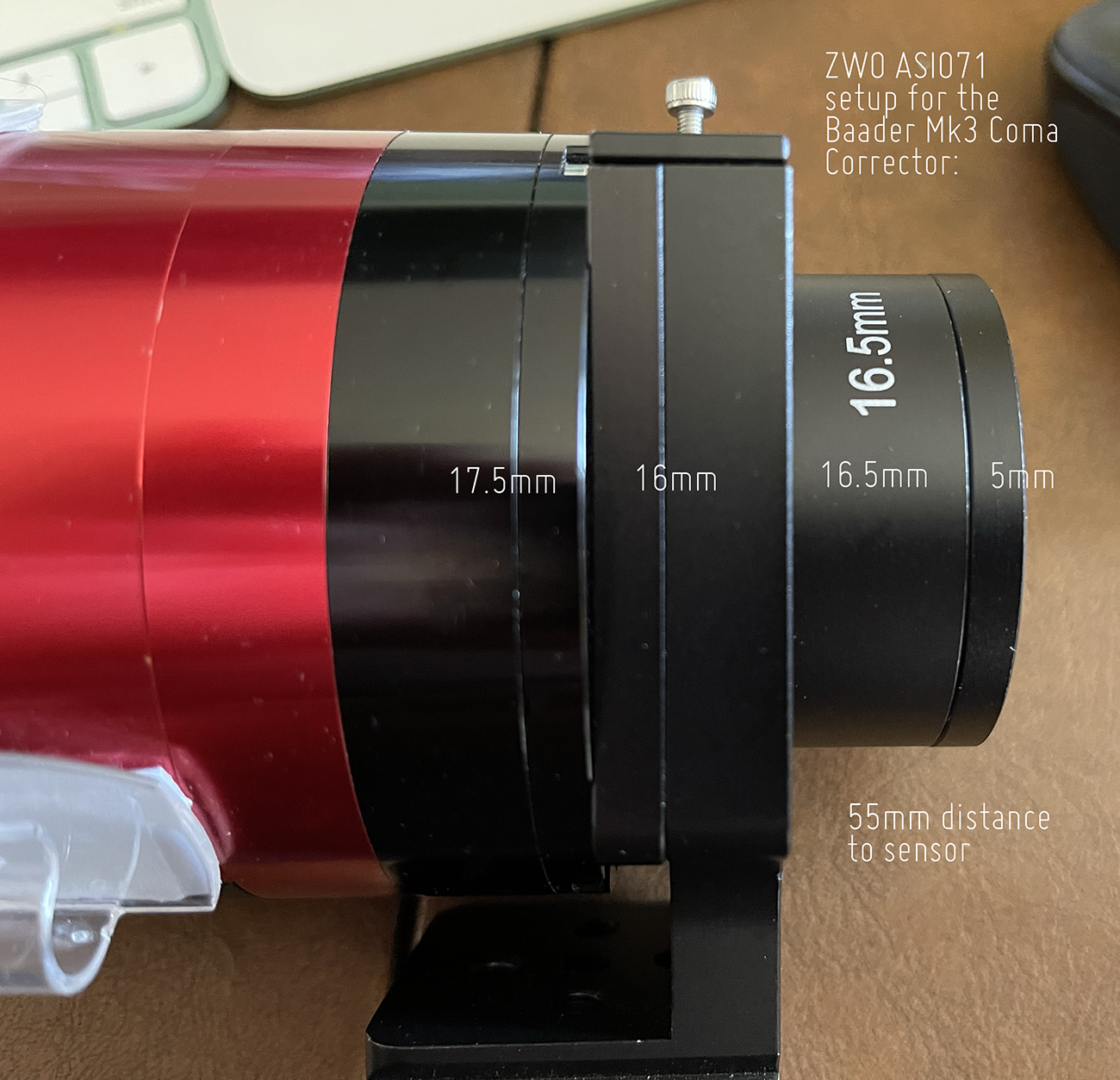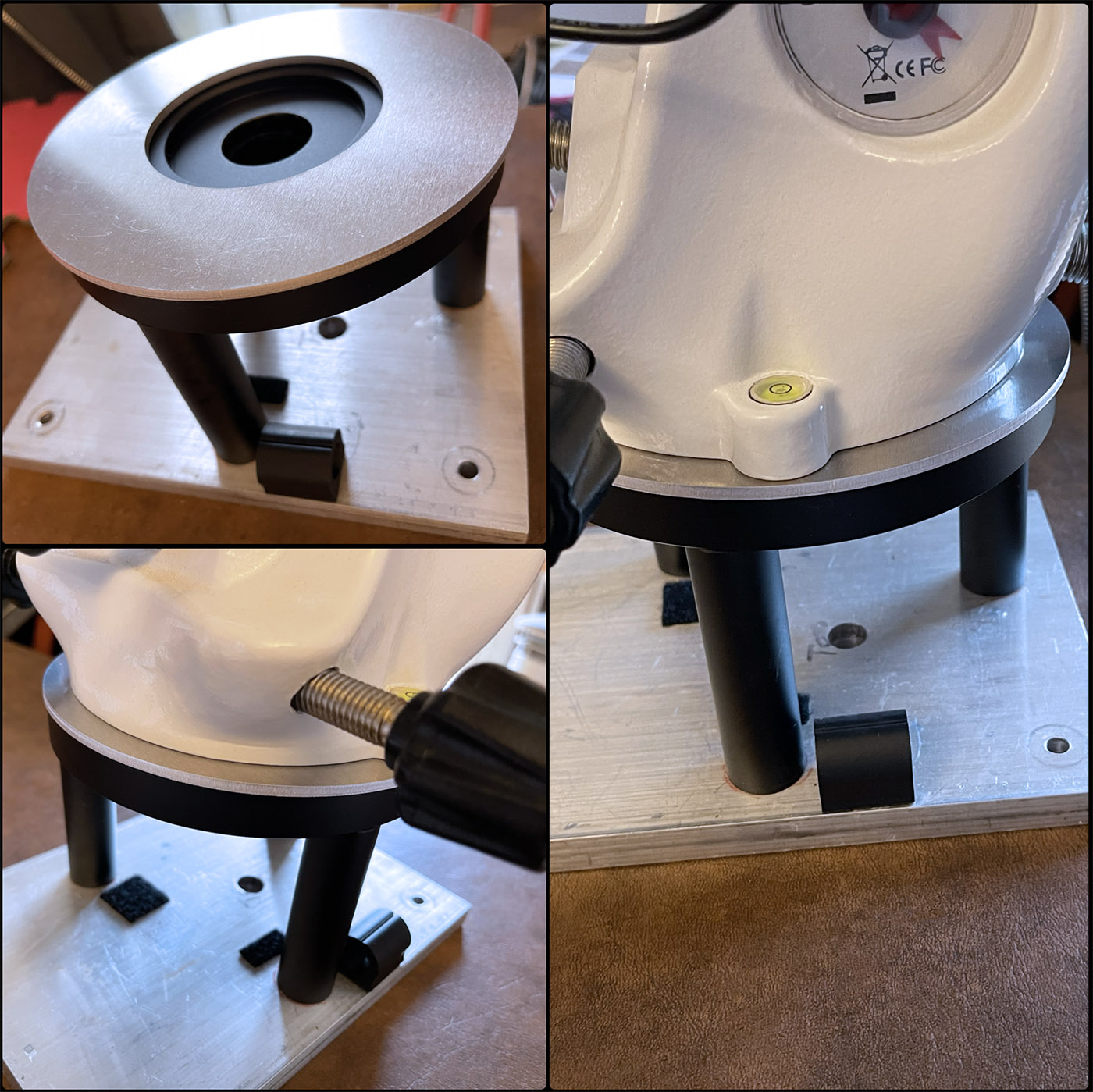The Baader Mark III Coma Corrector
I just ordered the Baader coma corrector for my 800mm f/4 Newt, and spent a few minutes getting the 55mm distance to sensor spacing right for the ZWO ASI071 camera.



Posted November 30, 2021
Rosette Nebula - without stars
The large HII region, the Rosette Nebula (Caldwell 49) in the Constellation Monoceros, with the stars removed from the image. This just shows the roughly 500 trillion miles of hydrogen clouds with the surrounding empty space.

Posted November 28, 2021
NGC 281, IC11, the Pacman Nebula in Ha
A wide-field narrowband (hydrogen-alpha) image of the Pacman Nebula in Cassiopeia. This emission nebula is a little under 10,000 lightyears away in the Perseus Spiral Arm of our galaxy, and it doesn't seem quite large enough for this view--except to show that Pacman is alone out there in this region of space (from our perspective). And that's one of the many cool aspects that makes NGC 281 fascinating to capture--there are so many others, an intense star-forming region, it's a great Hubble palette target, large examples of bok globules, X-ray imaging reveals a dense molecular clouds of hydrogen and carbon, feeding the process of star-creation, to name a few.
The double star eta Cassiopeiae (η Cassiopeiae) is the bright point of light above Pacman/IC 11 (brightest in the frame). Eta Cass. is made up of eta Cassiopeiae A, a sun-like G-type main-sequence star, and its smaller K-type orbiting companion, eta Cassiopeiae B. With a little research, this might be a cool SF world to tell a story around--the main star is like ours, but with an additional sun orbiting. And it's only 19.5 lightyears away.
Imaging notes: 57 x 300-second subs in 3 nanometer hydrogen-alpha. No calibration frames. Guiding was better than expected, with total RMS hovering between .7 and .9 arcseconds. Seeing was below average--astronomical seeing, which is impacted by turbulence and temperature differences in the atmosphere. It's pretty common to have a clear night with terrible seeing. There's a time and place for twinkling stars--like writing a song, but they're the bane of astrophotographers. Gear notes: ZWO ASI1600MM-Pro monochrome camera, Antlia 3nm Ha Pro narrowband filter, William Optics SpaceCat 51 apochromatic refractor, Sky-Watcher EQ6-R Pro mount.

Posted November 25, 2021
Orion Nebula, M42 and surrounding region
One more of the Orion Nebula, Running Man, De Mairan's Nebula (M43).

Posted November 21, 2021
M31, Andromeda Galaxy
Another one from last night's imaging run--finished up last night, with 34 subs from November 1st: Our largest galactic neighbor, Andromeda, with the William Optics SpaceCat 51 refractor and the ZWO ASI071MC cooled color camera.

Posted November 4, 2021
Orion Nebula (Messier 42)
From last night's imaging run: The Orion Nebula (M42) is one of my all-time favorite deep sky objects, and the Constellation Orion is in my top five places to go with a telescope. Imaging Notes: Ha+RGB, Ha: 55 x 240-second subs, color: 123 x 120-second subs stacked in DSS, processed in PSCC2022. William Optics SpaceCat51 Apo refractor, ZWO ASI071MC cooled color camera & ASI1600MM-Pro monochrome camera, Controller: INDI, Ekos, KStars.

Posted November 4, 2021
Something I've been meaning to correct for a while...
It's a gray rainy autumn day, so a good time to do a little upgrade. I ordered an ⅛" (3.2mm) thick aluminum spacer (6"/152mm OD x 3"/76mm ID) for the Orion Atlas pier adapter I use for both the Orion and the Sky-Watcher EQ6-R Pro. The Orion Atlas sits perfectly flat in the machined center and cut out ring, but the EQ6-R Pro sits slightly higher because the depth of the center is probably millimeter too shallow. Although the center bolt held it in place, the EQ6-R Pro always sat at a slight angle. I never liked that. Time to fix it with an aluminum spacer. I drilled a hole for the azimuth post, and we're back in business!


Posted October 30, 2021
M31 in BLUE
This is the blue bandpass of the Andromeda Galaxy (M31), revealing dense spirals of dust that wind through starfields and curl around the galactic core. I have labeled NGC 206, one of the brightest of the star clouds inside Andromeda, along with a couple of M31's captive galaxies (M32 and M101). Imaging Notes: 51 x 120-second stacked subs from my WilliamOptics SpaceCat51 (250mm FL) and ZWO ASi1600MM-Pro mono camera.

